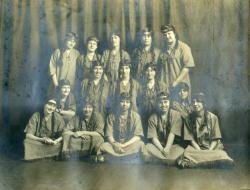
Soangetaha Campfire Girls, Farmington State Normal School, 1915
Mantor Library at UMF
In spring 1915, the first Camp Fire Girls group, Soangetaha, organized at Farmington State Normal School with Miss Carolyn Stone, who taught at the Normal School, as its guardian.
The Camp Fire organization’s purpose was to train girls to “greater efficiency, ..help them appreciate the beauty in nature, and …promote social life.” Its watchword was Wohelo (Work, Health and Love). Work accomplished by each girl was honored through the awarding of symbolic beads to be worn with a ceremonial costume. Each bead represented one of seven work divisions: home craft, health craft, hand craft, nature lore, camp craft, business and patriotism.

Campfire Girls, Farmington, 1918
Mantor Library at UMF
The law of the Camp Fire was:
Seek beauty
Give service
Pursue knowledge
Be trustworthy
Hold on to health
Glorify work
Be happy
As the girls earned their beads, they progressed through the ranks from Wood Gatherer, to Fire Maker, and then Torch Bearer.
Soangetaha had 20 members and held an ice cream sale in the fall with proceeds going to the Normal School's Christian Association. The members also crocheted items for the Association fair. Winter meetings included instruction in book-binding and the principals of bandaging.
The second Camp Fire group, Pierpole, was organized in fall 1915. According to the March 1916 issue of the Farmington Normal, the name was chosen to honor a Native American man who helped white settlers in the area. The Pierpoles and Soangetahas had a joint weenie roast at the slate quarry in the fall and a corn and weenie roast for the whole school later that year. The Pierpoles made tooled leather napkins rings and purses as well as divinity fudge for sale at the Christian Association fair. Their meeting guests included Miss Virginia Porter, one of the Normal School teachers, who taught them about writing business letters, telegrams and making out money orders and Captain Blake, the school's janitor, who showed them how to tie standard knots to help them earn their nature lore honors.

Sobeyaka Campfire, Farmington State Normal School, ca. 1917
Mantor Library at UMF
With so much student interest in Camp Fire membership, a third group called Siboweyaka (also referred to as Sobeyaka) was soon formed. Miss Inez Rolfe, one of the Normal School's Training School teachers, served as its guardian. The members made and beaded their own ceremonial dresses. For their first ceremonial meeting on April 15, 1916, they had a cookout at the slate quarry. They also enjoyed a snowshoeing hike, which was a relatively new outdoor activity at the time.
Another campfire group called Toheyaina was organized under the guardianship of Miss Jefferds in 1917. It had ten members. It did not appear to become one of the more popular groups, as there are few references to it in school records.
Three of the campfire groups – Soangetaha, Pierpole and Witawentin -- were each "recognized as a real organization on Feb 6 1921." According to the Farmington Normal, their activities included raking school lawns, campfire cookouts, raising money for Red Cross, selling Health Stamps, making scrapbooks for children’s hospitals, collecting clothing that was sent to an alumni teaching Household Arts in “a negro school" in Kentucky, and paying for the board of a young boy to spend the summer on a farm.
Source: Farmington Normal (various dates, 1915 - 1921)